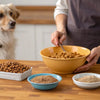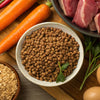What Do I Do If My Dog Won't Eat Kibble? A Comprehensive Guide for Concerned Pet Owners
- Houndsy
Table of Contents
- Introduction
- Reasons Why Dogs May Refuse Kibble
- Strategies to Encourage Eating
- Consider Alternative Diets
- When to Seek Help
- Conclusion
Introduction
Imagine preparing your dog's favorite meal, only to find them turning their nose up at it, leaving you puzzled and concerned. You're not alone—many dog owners face this frustrating scenario. According to veterinary studies, a sudden loss of appetite in dogs can be a common concern, affecting nearly 20% of dog owners at some point. This issue can stem from a variety of factors, ranging from medical conditions to behavioral quirks.
In this blog post, we will explore the reasons behind a dog's refusal to eat kibble and provide actionable strategies to help you address this issue effectively. We'll cover everything from understanding your dog's dietary needs to innovative solutions that can turn mealtime from a struggle into a joyous occasion. By the end of this guide, you will be equipped with the knowledge to enhance your pet’s dining experience and ensure they are receiving the proper nutrition they need.
So, let’s dive in! Have you noticed changes in your dog’s eating habits? Are you ready to explore new feeding techniques that can improve their appetite? Let’s explore the world of dog feeding and tackle the question: what do we do if our dog won’t eat kibble?
Reasons Why Dogs May Refuse Kibble
Understanding why our furry companions suddenly turn against their kibble can help us address the issue more effectively. Here, we’ll delve into the most common reasons behind this behavior.
Medical Issues
- Dental Problems: Dogs can experience dental issues that make chewing painful. Conditions like gum disease, tooth decay, or broken teeth can deter them from eating. It's essential to regularly check your dog's mouth and schedule veterinary dental cleanings.
- Gastrointestinal Disturbances: Digestive problems such as upset stomach, diarrhea, or parasites might cause discomfort, leading your dog to avoid food. If your dog shows signs of distress, consult your veterinarian.
- Illness or Pain: Conditions such as kidney disease or pancreatitis can significantly affect appetite. If your dog has not eaten for more than 24 hours, it’s crucial to seek professional help.
Behavioral Factors
- Picky Eater Syndrome: Some dogs develop preferences based on previous experiences. If they’ve been spoiled with table scraps or varied diets, they may become selective, turning away from kibble that seems less appealing.
- Changes in Environment: Dogs are creatures of habit. Changes in routine—like moving to a new home, new family members, or even changes in their feeding schedule—can cause anxiety, leading to a loss of appetite.
- Stress or Anxiety: Loud noises, such as thunderstorms or fireworks, and changes in their surroundings can lead to stress, making your dog reluctant to eat.
Kibble Quality and Preferences
- Food Quality: Not all kibble is created equal. Factors such as the quality of ingredients, freshness, and even the formulation can impact your dog’s willingness to eat. Always check the expiration date and consider switching to a high-quality kibble if needed.
- Flavor and Texture Preferences: Dogs have individual preferences, and they may simply prefer a different flavor or texture. Experimenting with different kibble brands or types (wet versus dry) can help identify what your dog enjoys most.
Strategies to Encourage Eating
Now that we understand the reasons behind kibble refusal, let’s explore effective strategies to encourage our dogs to eat.
Consult with Your Veterinarian
Before making any changes, it is vital to consult with your veterinarian to rule out any underlying medical issues. They can provide tailored advice based on your dog’s health and dietary needs.
Enhance Kibble Palatability
-
Add Tasty Toppers: Sprinkling a little bit of wet food, bone broth, or even mixing in some vegetables can make kibble more enticing. Here are a few ideas:
- Pumpkin Puree: A small amount can add flavor and is good for digestion.
- Cooked Chicken or Turkey: Lean meats can entice even the pickiest eaters.
- Low-Sodium Broth: Drizzling some broth can enhance both aroma and taste.
- Warm It Up: Just like us, dogs enjoy warm meals. Consider slightly warming their kibble by adding hot water or microwaving it for a few seconds (ensure it’s not too hot).
- Mix in Human Foods: Safe human foods like plain cooked rice, sweet potatoes, or carrots can be great additions. Just ensure that none of these ingredients are harmful to dogs (no onions or garlic!).
Create a Positive Feeding Environment
- Consistency is Key: Establish a routine for feeding times. Offer food at the same times each day and allow for a limited time to eat (15-20 minutes) before taking the food away.
- Reduce Distractions: Make sure your dog is eating in a quiet space. This can help alleviate any anxiety they might feel from a busy environment.
- Interactive Feeders: Use puzzle toys or slow feeders that challenge your dog and make mealtime fun. This can stimulate their interest in eating.
Monitor Portions and Treats
- Control Treat Intake: Ensure that treats make up no more than 10% of your dog’s daily calories. Over-treating can lead to a lack of interest in regular meals.
- Portion Control: Measure your dog's daily kibble and avoid free-feeding. Knowing they have a limited time to eat can motivate them to finish their meal.
Experiment with Different Kibble Brands
If your dog continues to refuse kibble, it may be time to explore other brands. Look for high-quality kibble with natural ingredients that cater to your dog's preferences and dietary needs.
Consider Alternative Diets
If your dog’s refusal to eat kibble persists, it might be worth considering alternative diets. Here are a few options you can explore:
Canned Dog Food
Canned food can be a more appealing option for many dogs due to its moisture content and aroma. It’s also easier to chew, making it suitable for dogs with dental issues.
Fresh Dog Food
Fresh dog food options, like those offered by Ollie, can provide high-quality, human-grade meals customized to your dog's dietary needs. These meals are prepared with fresh ingredients and can help encourage picky eaters to enjoy their meals. Explore the Houndsy Kibble Dispenser to keep your dog’s food fresher for longer.
Raw Diets
Some pet owners opt for raw diets, which include raw meats, fruits, and vegetables. However, it’s essential to consult with a veterinarian or a veterinary nutritionist before making this change, as it requires careful balancing to avoid nutritional deficiencies.
When to Seek Help
If your dog continues to refuse food for more than 24 hours, or if you notice other concerning symptoms such as vomiting, diarrhea, lethargy, or weight loss, it’s crucial to consult with your veterinarian immediately. These signs could indicate a serious underlying condition that requires prompt attention.
Conclusion
We hope this comprehensive guide has empowered you with the knowledge to address your dog’s refusal to eat kibble. Remember, understanding the reasons behind their behavior is the first step toward a solution. By enhancing the palatability of their food, creating a positive feeding environment, and considering alternative diets, we can transform mealtime into a joyful part of your dog's day.
As a pet care brand dedicated to enhancing the daily feeding experience, we at Houndsy offer innovative solutions like the Houndsy Kibble Dispenser to ensure your dog’s meals are not only convenient but also enjoyable. With our commitment to quality, design excellence, and pet well-being, we are here to support you in your pet care journey.
FAQ
1. Why is my dog suddenly refusing to eat kibble?
There are multiple reasons, including medical issues, dental problems, or behavioral factors. If your dog shows signs of distress or refuses to eat for more than a day, consult your veterinarian.
2. How can I make kibble more appealing to my dog?
Try adding toppers like wet food, low-sodium broth, or warm water. You can also mix in safe human foods to entice them.
3. Should I be worried if my dog won’t eat for more than 24 hours?
Yes, a loss of appetite can be a sign of illness. If your dog hasn’t eaten for this long, it’s best to consult your veterinarian.
4. Are there alternatives to kibble if my dog won’t eat it?
Yes, you can explore options like canned dog food, fresh dog food, or a raw food diet, but consult with your vet before making significant dietary changes.
5. How can I encourage my dog to eat in a consistent routine?
Establish a regular feeding schedule, limit the time food is available, and eliminate distractions during mealtimes.













